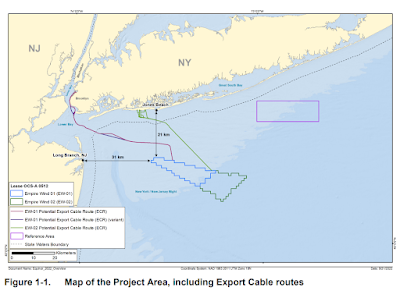The Real Energy Crisis Isn’t Offshore Wind — It’s Politics and the Power Market
By Capt. Paul Eidman
Marine Conservation Advocate
New Jersey’s energy debate has drifted far off course. What began as a necessary conversation about how to power our state sustainably has been hijacked by political talking points. Some critics now claim that offshore wind and Governor Murphy’s Energy Master Plan are to blame for high utility bills and marine degradation. That’s simply not true — and it distracts from the real culprits driving costs and straining our environment.
Let’s start with the facts. Offshore wind has not yet delivered a single kilowatt-hour to the grid, so it cannot be responsible for current rate hikes. The real price pressure comes from the regional grid operator, PJM, whose auction system rewards aging fossil fuel plants for “capacity” instead of promoting clean, in-state generation. Add to that the explosion of energy-hungry data centers, which consume massive amounts of electricity, and you have a system where corporate demand — not clean energy investment — is inflating costs for New Jersey families.
Offshore wind, in contrast, is a long-term stabilizer. Once built, its fuel is free, its output is predictable, and it reduces our exposure to volatile gas prices that have repeatedly driven up rates in recent years. Offshore wind is not a cost burden — it’s an insurance policy against future price shocks.
Critics like to point to Ørsted and Shell’s project cancellations as proof of “failure.” In reality, these were financial timing setbacks caused by inflation, supply chain bottlenecks, and a poorly synchronized federal auction schedule — not technical or environmental problems. The global offshore wind industry remains strong and growing, and other states are successfully recalibrating their procurement processes to adapt. New Jersey should do the same — not retreat into outdated fossil dependence.
As a Marine Affairs Officer, I take any claim of ocean harm seriously. But we have to follow the science, not the headlines. Every major federal agency — NOAA, BOEM, NMFS — has confirmed that there is no evidence linking offshore wind surveys to whale strandings. The far greater threats to marine life are climate change, ocean warming, acidification, and vessel strikes — all linked to the fossil fuel pollution that offshore wind helps displace.
In fact, offshore wind development has prompted unprecedented investment in marine science — benthic habitat mapping, eDNA sampling, and regional fishery studies that are expanding our understanding of ocean ecosystems. Never before have we had this level of coordinated research and monitoring along the Atlantic seaboard.
Let’s also clear up another misconception: supporting offshore wind does not mean opposing fishing, boating, or coastal economies. I’ve spent my life on these waters. I’ve seen the impacts of warming seas, shifting fish populations, and harmful algal blooms that hurt fishermen and coastal businesses alike. Offshore wind, done responsibly, can coexist with these industries — as proven in Europe, where careful spatial planning and compensation programs allow fishing and clean energy to thrive side by side.
What truly threatens New Jersey’s $4 billion outdoor recreation economy is climate inaction. Rising sea temperatures, coastal erosion, and extreme weather are already changing the marine environment faster than many species can adapt. Ignoring that reality while blaming wind projects is shortsighted and dangerous.
Those who argue that New Jersey should stick with “diversified” energy — meaning more natural gas — are missing the point. Gas may seem cheap today, but its price is set by global markets. It remains one pipeline disruption away from another spike. Offshore wind and nuclear together provide the diversity and reliability our grid needs — clean, domestic power insulated from global fuel volatility.
Energy policy should be based on science and facts, not fear or political convenience. Offshore wind is not the enemy of affordability or the environment. It’s part of the solution — alongside nuclear, solar, and smarter grid management.
If we truly care about keeping energy affordable, reliable, and environmentally sound, we should be reforming PJM’s outdated market structure, holding data centers accountable for their massive energy consumption, and accelerating — not abandoning — clean domestic generation.
New Jersey doesn’t have to choose between a healthy environment, a thriving economy, and affordable energy. With the right leadership and commitment to truth, we can have all three.




Comments
Post a Comment